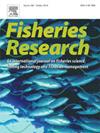Bibliometric insights into fisheries value chain research
IF 2.2
2区 农林科学
Q2 FISHERIES
引用次数: 0
Abstract
The fishing and aquaculture sectors play a pivotal role in global food and nutritional security, with significant contributions to employment and revenue. Historically, fisheries assessment has emphasised ecological aspects, but a holistic approach recognising the sector's intricate dynamics, from harvest to end-user, is essential to overcome challenges like overfishing and economic losses. This study employed a bibliometric approach to map the fisheries value chain literature, aiming to understand research developments, key contributors, and collaboration dynamics, and offer a perspective on the shifts in scientific trends and research priorities. After extracting data from Web of Science and Scopus databases, employing a keyword-based search strategy, a final dataset of 396 articles was analysed using established performance analysis and science mapping techniques. Fisheries value chain research has seen consistent growth since 2002, with a notable increase between 2019 and 2020. The USA is a key contributor to this research, with collaborations involving Norway, the UK, and Australia. Key authors have distinct areas of focus, from governance to seafood trade. While collaboration is frequent, geographical constraints may limit some. Thematic analysis indicates that most research focuses on addressing industry challenges and governance frameworks. Themes such as by-product utilisation are underexplored and require further development. Socioeconomic themes, including market demand and food security, have broad relevance and play an important role across various research areas. This study provides a comprehensive overview of fisheries value chain research, guiding future research.
渔业价值链研究的文献计量学见解
渔业和水产养殖部门在全球粮食和营养安全方面发挥着关键作用,为就业和收入做出了重大贡献。从历史上看,渔业评估强调的是生态方面,但要克服过度捕捞和经济损失等挑战,必须采取全面的方法,认识到该部门从收获到最终用户的复杂动态。本研究采用文献计量学方法绘制渔业价值链文献图,旨在了解研究进展、关键贡献者和合作动态,并为科学趋势和研究重点的转变提供视角。从Web of Science和Scopus数据库中提取数据后,采用基于关键字的搜索策略,使用既定的性能分析和科学映射技术对396篇文章的最终数据集进行了分析。渔业价值链研究自2002年以来持续增长,2019年至2020年期间显著增长。美国是这项研究的主要贡献者,与挪威、英国和澳大利亚合作。主要作者有不同的重点领域,从治理到海鲜贸易。虽然合作频繁,但地理限制可能会限制一些合作。专题分析表明,大多数研究集中于解决行业挑战和治理框架。副产品利用等主题尚未得到充分探索,需要进一步发展。社会经济主题,包括市场需求和粮食安全,具有广泛的相关性,并在各个研究领域发挥重要作用。本研究为渔业价值链研究提供了一个全面的概述,指导未来的研究。
本文章由计算机程序翻译,如有差异,请以英文原文为准。
求助全文
约1分钟内获得全文
求助全文
来源期刊

Fisheries Research
农林科学-渔业
CiteScore
4.50
自引率
16.70%
发文量
294
审稿时长
15 weeks
期刊介绍:
This journal provides an international forum for the publication of papers in the areas of fisheries science, fishing technology, fisheries management and relevant socio-economics. The scope covers fisheries in salt, brackish and freshwater systems, and all aspects of associated ecology, environmental aspects of fisheries, and economics. Both theoretical and practical papers are acceptable, including laboratory and field experimental studies relevant to fisheries. Papers on the conservation of exploitable living resources are welcome. Review and Viewpoint articles are also published. As the specified areas inevitably impinge on and interrelate with each other, the approach of the journal is multidisciplinary, and authors are encouraged to emphasise the relevance of their own work to that of other disciplines. The journal is intended for fisheries scientists, biological oceanographers, gear technologists, economists, managers, administrators, policy makers and legislators.
 求助内容:
求助内容: 应助结果提醒方式:
应助结果提醒方式:


